WHAT YOU REALLY NEED TO KNOW
ABOUT COSMETIC SURGERY
Full Text from Dr. Berman's Book
Chapter 13
LIPOSUCTION
In many surveys, liposuction has been noted to be the most popularly performed of all the cosmetic surgical procedures. Less than 20 years ago this procedure wasn't even being performed. Up until 1985, it wasn't even accepted as a legitimate surgical operation by some of the major plastic surgical societies in the U.S.. So, with all of the concerns about potential hazards of the operation, one might think it surprising that this relatively new procedure has climbed to the top of the heap. On the other hand, it may be that people are coming to terms with their undesired genetic distribution of fat.
What do you do if you have an area of fat that is resistant to diet and exercise? Sometimes it's just more expedient to remove it rather than go on an aggressive diet program. Its not unusual to find people who have tried several diet and exercise programs and simply can't reduce unsightly bulges. The young woman with the "saddle-bag" deformity (fatty deposits on her thighs) may diet and exercise until she is skin and bones from the waist up and still be stuck with her thigh bulges. Such problems gave birth to liposuction. Actually, re-birth, might be more appropriate. For early attempts to remove fat deposits, met with disaster. But now, we have safe and effective techniques that allow for the removal of unwanted fat.
Although liposuction has traditionally been used to remove isolated areas of fat that exercise and diet don't seem to help, occasionally, we have expanded our indications. In some cases when a person has diffuse amounts of excessive fat, liposuction can actually be helpful in conjunction with more traditional weight loss programs. This occurs by reducing the overall fat volume and helping to raise the metabolic rate. The number of fat cells we have are essentially determined during conception and perhaps up through the first year of life. High caloric and fatty diets can certainly increase our weight, but generally the number of fat cells remains constant. Removing a lot of those cells, means there are less fat cells to "soak up" the insulin, adrenaline, lipases, thyroid hormone and many of the other metabolites necessary to do the body's work. This may in part explain why "fat" people who have a lower metabolic rate, are more prone to develop diabetes, and suffer from hormonal irregularities. Studies have been done with twins separated from birth. Regardless of the environment in which they were raised, they would develop similar body types. Simply, thin twins raised by a fat and thin family would still grow up to be thin while fat pre-disposed twins raised by a thin and a fat family would grow up fat. This might help heavy people come to a better understanding of their situation. It is not merely a case of over-indulgence. So, it is not without merit then, that removing a substantial number of fat cells may facilitate weight loss. I've seen several cases, where liposuction has been done, sometimes two or three times even, and only then the patient is able to remain thin, actually eating normally and finally enjoying a more efficient metabolism. Other metabolic changes have been seen as well. For example, occasionally women who complain of cold feet, might notice that after liposuction, there is improvement in the warmth of their toes, perhaps from more free circulating adrenaline. I've seen several cases where patients have had an increase in their breast size following liposuction, probably from a relative increase in concentration of freely circulating estrogen. The physiologic influences of fat and its removal is a lot broader than generally has been appreciated.
Fat cells do have a positive function, it's just that too much (or too little) may be unsightly. A nice distribution of fat imparts a pleasant shape. Fat provides cushioning and insulation. It provides an excellent lubricant for the movement of the surrounding tissues. Certainly, it is a source of energy, in fact, the most efficient source, yielding 9 calories per gram. Also, the fat cells provide a reservoir for consumed fat. So in a contrary sense, if liposuction were performed, but a high fat diet was maintained, then the circulating fat would have fewer peripheral reservoirs. This would conceivably cause an increased health risk by increasing fat concentration in the bloodstream and the central circulation, thus potentially clogging important blood vessels, such as the coronary arteries. Of course, "yo-yo" dieting probably causes the same problem, releasing fat into the bloodstream as it is metabolized. Liposuction would directly remove the fat without it needing to course one's circulation.
Liposuction surgery has evolved considerably since the late 70's and early 80's. Initially, the procedures were done under general anesthesia using fairly large bore cannula (the metal instrument that is introduced under the skin to suction the fat) connected to very powerful vacuum machines. Many patients who had undergone this procedure will tell of considerable bruising and pain, hobbling around for weeks while the healing process took place. The large cannula and vacuum machines were very traumatic, especially when combined with the peripheral vasodilatation effects of general anesthesia (the peripheral blood supply was expanded, thus easily injured with more bleeding around the fat). I would venture to say that many surgeons today still prefer general anesthesia. Indeed, when larger procedures are planned, patients are often asked to donate two or three units of their own blood prior to surgery with the plan of giving it back during the course of their operation.
However, several years ago, I adopted a different approach to liposuction. This "new" technique has become increasingly popular, recently described on several television shows as a breakthrough in liposuction surgery. It is generally referred to as the "tumescent technique." I actually use a modified tumescent technique which is combined with intravenous sedation. Through an established intravenous line, medication is given so that the patient may sleep, yet continue breathing on their own. Once adequately sedated, a dilute local anesthetic is injected (without the patient feeling it) just under the skin. This blocks the nerves under the skin that originate from the dermatome plexus, a key source of sensory nerves not often considered. This also helps to decrease blood flow from the skin side down to the fat. Then, using a special 2mm blunt tipped needle, the Klein needle, developed by Dr. Jeffrey Klein, a large quantity of dilute local anesthesia is injected deeper into the fat, flooding the area sufficiently that it feels somewhat firm, in other words tumescent. I then use small diameter canulas (2, 3, and 4 mm) and a large (60 ml) syringe, or occasionally a machine, to provide the suction. This is performed through tiny "stab" wounds which are routinely closed with a single dissolving suture. This technique has many advantages. Anesthesia is safer with minimal recovery time and avoids possible adverse affects of general anesthesia. There is very little bleeding from this technique, subsequently there is much less bruising and much less pain than the more traditional approach. Patients can usually return to work within 2 to 4 days following surgery. And, unlike pure local anesthesia, intravenous sedation allows the patient to comfortably sleep throughout the procedure.
A few words about ultrasound liposuction, or UAL (ultrasound assisted liposuction), should be mentioned. By using an ultrasound device, the fat cells are ruptured (cavitation) leaving the grease behind. The idea is to then simply explode the fat cells without injuring the skin, nerves or blood vessels and then remove the fat with less trauma to the patient. In theory, its a good idea, and some doctors are aggressively pursuing this new technology. Unfortunately, the Europeans have had five years experience with the ultrasound and ran into many difficulties, most commonly, burn injuries to the skin. There are improvements, however, with the technology, which may bring it into more popular use. I've had some limited experience with different units and can tell you that some are only going to make a simple and safe procedure much more risky. However, there are some units I am impressed with and believe they might be quite useful, particularly in dealing with traditionally more difficult areas where there is abundant fibrous tissue.
We are also learning about external; ultrasound and electric stimulation as tools to help with post-operative recovery. Some doctors are even using external ultrasound to prepare the potential liposuction site for surgery. Clearly, this is still an area where we are searching for better forms of treatment.
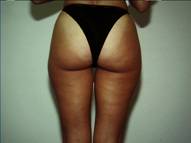
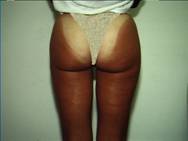
Liposuction can be used to enhance minimal deformities, such as lateral and medial thigh fullness.
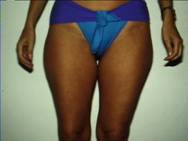
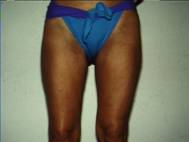
Another example of minimal thigh deformity which is improved with liposuction.
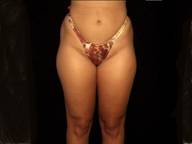
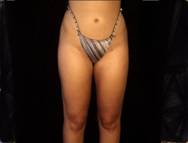
Contour irregularities in the hips, buttocks and thighs are improved with a session of liposuction surgery.
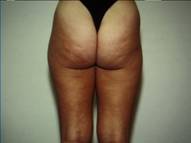
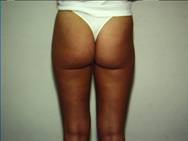
Larger accumulations of fat can be reduced following liposuction, and often skin contours are enhanced as the so-called "cellulite" is reduced.
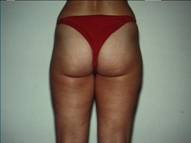
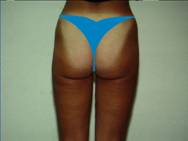
Some patients try many different diet and exercise programs without success. After adequate liposuction, many patients find that they can easily keep the weight off, that their metabolic rate actually seems to increase, and they no longer have to stay on such rigid diets.
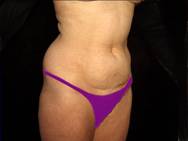
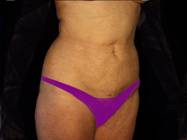
Contours of the hips and abdomen can be enhanced, though there may be some mild rippling of the skin depending on one's age and skin elasticity.
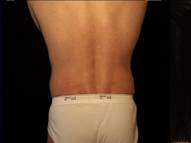
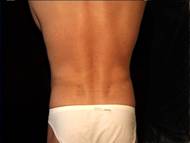
Barely noticeable, but a bother to the patient nonetheless, the so-called "love-handles" or flank fat, is nicely reduced using liposuction.
Liposuction can be used for fat problems from head to toe. In the head, it is most often used under the chin. It is rarely, though occasionally, used in the face. It is not used around the eyelids, where traditional excisional techniques are safer. It can be used in the arms, the chest, the back, waist, abdomen, hips, buttocks, thighs, knees, and ankles. Often, it is useful in men who have over developed breasts (male gynecomastia). Occasionally, it can be used to remove (or decrease significantly) lipomas (benign fatty tumors) without large excisional scars. And of course, it was liposuction that gave birth to the idea of fat grafting or liposculpture, so that we don't have to think only in terms or removing fat, but can also be free to redistribute or reposition fat for enhanced contours.
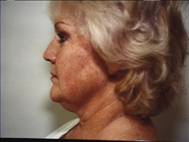
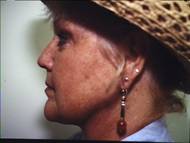
This patient didn't want to undergo a traditional face-lift, so we opted for liposuction under her chin. Her recovery was rapid and her results are better than I would have predicted.


This young woman is a good candidate for sub-mental liposuction. She has a fairly large accumulation of congenital fat under her chin and responded well to treatment.
Complications from liposuction have become less frequent in experienced hands. Infection is fortunately very rare. Bleeding, especially with the newer techniques, has not been a concern in my practice. Large quantities of fat can be safely removed with the tumescent technique. Actually, the concern with treatment is really directed toward the amount of surface area breached as opposed to the amount of fat removed. Clearly, it would be much safer to remove 3,000 cc's of fat confined to someone's very prominent saddle bag deformity, then it would be to remove the same amount from many spots of a slightly overweight patient. The most common problem with liposuction is usually due to rippling of the skin or too much removal of fat. Skin that has poor elasticity is not likely to re-drape as well as youthful, elastic skin. Dimples caused from too much fat removal can usually be corrected later with fat grafting or revision liposuction surgery.
Following the operation the patient is fitted with a very snug compressive garment. This helps the tissues properly re-drape and collapses the potential space where the fat has been removed to limit bruising and the accumulation of post-operative fluid (edema). The garment is usually worn continually for one week and occasionally longer.
Following liposuction, good nutrition and exercise remain important parts of a healthy lifestyle and insure the best long-term results. It is often gratifying to see patients make positive life style changes following liposuction, realizing their investment applies to good health as well as improved appearance. It also helps ensure nice looking results.